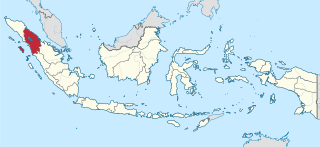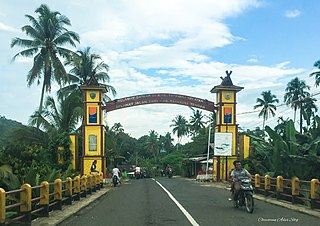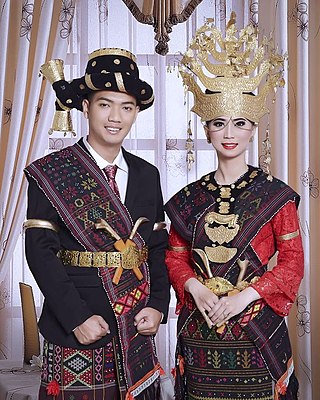
North Sumatra is a province of Indonesia located on the northern part of the island of Sumatra. Its capital and largest city is Medan. It is bordered by Aceh on the northwest and Riau and West Sumatra in the southeast, with two different coastlines located on the Indian Ocean and the Strait of Malacca, and a maritime border with Malaysia to the east. North Sumatra is Indonesia's fourth most populous province after West Java, East Java and Central Java, and the third-largest province on the island of Sumatra after the neighbouring Riau. It covers an area of 72,981 km2. According to the 2020 census, the province's population in that year was 14,799,361. The mid-2022 official estimate was 15,115,206. North Sumatra is a multi-ethnic province. The Malay people are regarded as the natives of the east coast of the province, while the west coast of the province is mainly inhabited by the Batak. The central highlands region around Lake Toba is predominantly inhabited by other Batak groups. The Nias people are natives to Nias Island and its surrounding islets. With the opening of tobacco plantations in East Sumatra during the colonial era, the colonial government employed many contract labourers for plantations, mainly Chinese, Javanese and Indian migrants. The majority did not return after their contract ended and decided to stay in the province. The recent rapid urbanisation also attracted neighbouring people from Aceh, Riau and West Sumatra.

Batak is a collective term used to identify a number of closely related Austronesian ethnic groups predominantly found in North Sumatra, Indonesia, who speak Batak languages. The term is used to include the Karo, Pakpak, Simalungun, Toba, Angkola, and Mandailing ethnic groups. Which are related groups with distinct languages and traditional customs (adat).

Sibolga is a city and a port located in the natural harbour of Sibolga Bay on the west coast of North Sumatra province, in Indonesia.

The Batak languages are a subgroup of the Austronesian languages spoken by the Batak people in the Indonesian province of North Sumatra and surrounding areas.

Chaah is a town and mukim in Segamat District, Johor, Malaysia. It is the southernmost mukim in the district, but it is administered as a suburb of Labis.

The Mandailing is an ethnic group in Sumatera, Indonesia that is commonly associated with the Batak people. They are found mainly in the northern section of the island of Sumatra in Indonesia. They came under the influence of the Kaum Padri who ruled the Minangkabau of Tanah Datar. As a result, the Mandailing were influenced by Muslim culture and converted to Islam. There are also a group of Mandailing in Malaysia, especially in the states of Selangor and Perak. They are closely related to the Angkola and Toba.

Karo Regency is a landlocked regency of North Sumatra, Indonesia, situated in the Barisan Mountains. The regency covers an area of 2,127.25 square kilometres (821.34 sq mi) and according to the 2010 census it had a population of 350,479, increasing to 404,998 at the 2020 Census; the official estimate as at mid 2022 was 414,429. 60.99% of the regency is forested. Its regency seat is Kabanjahe. The Batak Karo language is spoken in the regency, as well as the Indonesian language. It borders Southeast Aceh Regency in Aceh to the west, Deli Serdang Regency and Langkat Regency to the north, Dairi Regency and Toba Samosir Regency to the south, and Deli Serdang Regency and Simalungun Regency to the east.

Humbang Hasundutan Regency is a landlocked regency in North Sumatra province of Indonesia. In the east of the regency, Baktiraja District stretches along a short part of the southern shore of Lake Toba in North Sumatra. The regency covers an area of 2,502.71 km2, and it had a population of 171,687 at the 2010 census and 197,751 at the 2020 census; the official estimate as at mid 2022 was 202,299. Its seat is the town of Dolok Sanggul. To the north is Samosir Regency and Pakpak Bharat Regency, to the east is North Tapanuli Regency, and to the west and south is Central Tapanuli Regency, and beyond the latter the Indian Ocean.

Mandailing Natal, abbreviated as Madina, is a regency in North Sumatra Province of Indonesia. It covers an area of 6,620.70 square kilometres and it had a population of 403,894 people at the 2010 census and 472,886 at the 2020 Census; the official estimate as at mid 2022 was 484,874. The capital lies at Panyabungan. The Regency was a former part of South Tapanuli Regency until it was created as a separate regency on 23 November 1998.

Padang Lawas is a regency in North Sumatra province of Indonesia. It covers an area of 3,912.18 km2, and had a population of 226,807 at the 2010 Census and 261,011 at the 2020 Census; the official estimate as at mid 2022 was 267,275. Its administrative seat is the town of Sibuhuan. Padang Lawas Regency was created on 17 July 2007 from southeastern parts of the South Tapanuli Regency.

North Padang Lawas is a regency in North Sumatra province of Indonesia. It has an area of 3,918.05 km2, and had a population of 223,049 at the 2010 census and 260,720 at the 2020 census; the official estimate as at mid 2022 was 267,275. North Padang Lawas Regency was created on 17 July 2007 from eastern parts of the South Tapanuli Regency. Its administrative seat is the town of Gunung Tua.

South Tapanuli is a regency in North Sumatra, Indonesia. Its seat is the town of Sipirok. This regency was originally very large and contained thousands of towns and villages, including the city of Padang Sidempuan. The areas that have separated from South Tapanuli Regency are the new regencies of Mandailing Natal, Padang Lawas Utara and Padang Lawas, all lying to the south-east of the residual South Tapanuli Regency, plus the city (kota) of Padang Sidempuan. After the division, the regency seat moved to from Padang Sidempuan to Sipirok.

Central Tapanuli Regency is a regency in North Sumatra province, Sumatra, Indonesia. The seat of regency government is at Pandan. The regency covers an area of 2,194.98 km2 and consists of a long extent of land along the western coast of North Sumatra, together with offshore islands of which the largest is Mursala Island; it had a population of 311,232 at the 2010 census and 365,177 at the 2020 Census; the official estimate as at mid 2022 was 374,734. The regency surrounds on the landward side the city of Sibolga, which is administratively separate from the regency.

North Tapanuli Regency is a landlocked regency in North Sumatra province, Sumatra, Indonesia. Its capital is Tarutung. The regency covers an area of 3,793.71 square kilometres and it had a population of 278,897 at the 2010 Census and 312,758 at the 2020 Census; the official estimate as at mid 2022 was 318,424.

Toba Batak people are the largest ethnic group of the Batak peoples of North Sumatra, Indonesia. The common phrase of ‘Batak’ usually refers to the Batak Toba people. This mistake is caused by the Toba people being the largest sub-group of the Batak ethnic and their differing social habit has been to self-identify as merely Batak instead of ‘Toba’ or ‘Batak Toba’, contrary to the habit of the Karo, Mandailing, Simalungun, Pakpak communities who commonly self-identify with their respective sub-groups.
Aek Godang Airport is an airport in South Tapanuli Regency, North Sumatra, Indonesia.

Angkola people are a Batak ethnic group from North Sumatra who live in South Tapanuli regency. The Angkola language is similar to Mandailing language also with Toba language, but it is sociolinguistically distinct.

Abdul Hakim Harahap was an Indonesian politician who held various positions, including deputy prime minister, in the 1950s.

Raja Junjungan Lubis was an Indonesian Mandailing politician who became the Regent of Batanggadis, Regent of Central Tapanuli, Mayor of Sibolga, Governor of North Sumatra, and member of the People's Representative Council.
Gereja Kristen Protestan Angkola is a church Christian Protestant synod in Indonesia with its head office in Padangsidimpuan, North Sumatra province. This church organization was officially established on October 26, 1975 when it obtained autonomy from Huria Kristen Batak Protestant (HKBP), under the name HKBP-A. In 1988 it merged with the "Angkola Protestant Church (GPA)", and began to take the name "Angkola Protestant Christian Church". GKPA serves specifically the Angkola Batak community in their local language.

















